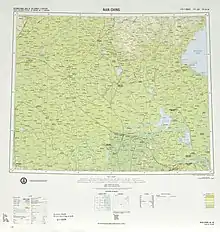Nan-ching
English

Map including NAN-CHING (DMA, 1975)
Etymology
From Mandarin 南京 (Nánjīng) Wade–Giles romanization: Nan²-ching¹.[1]
Pronunciation
- enPR: nänʹjǐngʹ
Proper noun
Nan-ching
- Alternative form of Nanjing
- 1865, David Field Rennie, M.D., Peking and the Pekingese, volume II, London: John Murray, page 42:
- September 6th.-The English mail of the 10th of July arrived to-day, and while Mr. Hart was at the Foreign Office engaged on business with Wan-se-ang and Hang-Ki, he received his Shang-hai letters, one of which contained the news of the recapture by the Imperial forces of the cities of Woo-tu and Nan-ching, two important rebel posts.
- 1969, Yi-Fu Tuan, China, Chicago: Aldine Publishing Company, →ISBN, →LCCN, →OCLC, page 22:
- Aside from the Turfan depression in Hsin-chiang (Sinkiang) province, the hottest part of China lies in the middle and lower Yangtze Valley. Maximum temperatures of 43°-44°C (110°-112°F) have been recorded in Ch'ang-sha and Nan-ching.
- 1974, John H. Winkelman, The Imperial Library in Southern Sung China, 1127-1279 : A Study of the Organization and Operation of the Scholarly Agencies of the Central Government, →ISBN, →LCCN, →OCLC, →OL, page 12:
- Early in the summer of 1127 the emperor was located near the city of Nan-ching just south of the Yangtze River.
Translations
Nanjing — see Nanjing
References
- Nanjing, Wade-Giles romanization Nan-ching, in Encyclopædia Britannica
Further reading
- “Nan-ching”, in Collins English Dictionary.
- “Nan-ching”, in OneLook Dictionary Search.
- “Nan-ching” in TheFreeDictionary.com, Huntingdon Valley, Pa.: Farlex, Inc., 2003–2024.
Anagrams
This article is issued from Wiktionary. The text is licensed under Creative Commons - Attribution - Sharealike. Additional terms may apply for the media files.